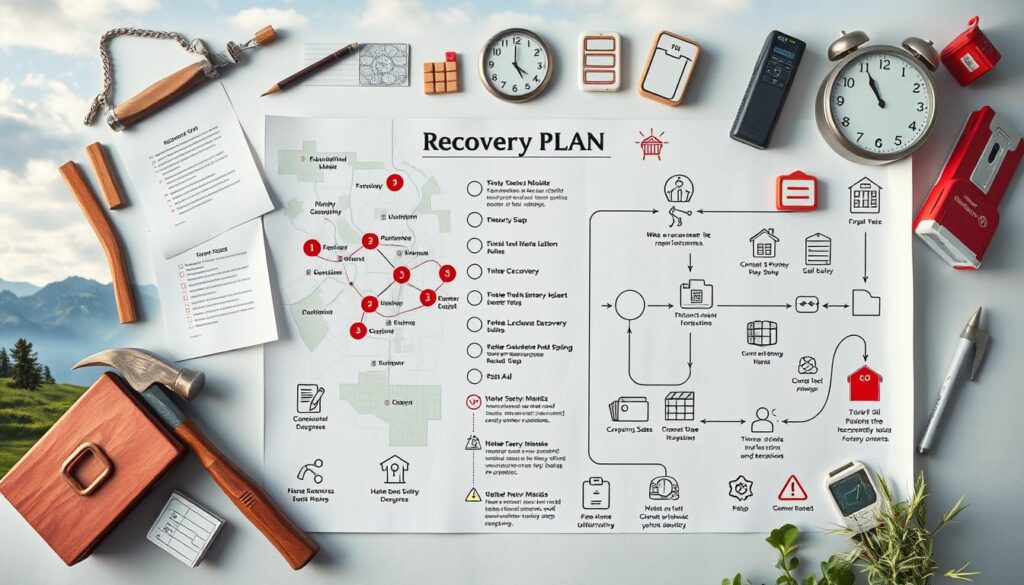Disaster recovery and preparedness are key for businesses to keep going. Many communities are not ready for disasters. Local governments face a long rebuilding process, sometimes taking years.
Getting ready for disasters takes time. It can take a decade or more. But, local governments that prepare see better results against natural hazards.
Working with local people makes recovery plans better. This makes them more useful for the community. Having local rules and plans helps make better decisions after disasters.
Disaster recovery is more than just reacting. It’s also about preventing and reducing disaster effects.
Key Takeaways
- Disaster recovery preparedness is essential for business continuity
- Local governments can benefit from implementing preparedness initiatives
- Engaging local stakeholders enhances the applicability of recovery guidelines
- A cohesive permitting process can streamline recovery efforts
- Disaster recovery plans can improve post-disaster decision-making and environmental conservation
- Collaborative approaches can ensure efficient and inclusive recovery processes
- Scalable responses can be implemented according to the nature and severity of the incident
Understanding the Fundamentals of Disaster Recovery
Creating a solid disaster recovery plan is key for businesses to cut losses and keep running during disasters. A good emergency plan helps companies bounce back fast and well. FEMA says that planning for hazards is the base of community strength, making disaster recovery basics vital.
A disaster recovery plan should cover prevention, anticipation, and mitigation. Prevention strategies try to lower the chance of tech disasters. Anticipation is about getting ready for disasters, and mitigation aims to lessen their effects. It’s also smart to test disaster recovery plans often to check if they work.
Important parts of a disaster recovery plan include making regular backups and having a backup work plan. It’s also key to sync IT disaster plans with other safety efforts. With a strong plan, companies can cut downtime costs by 75% and bounce back in under 24 hours.
Key Components of Recovery
- Prevention strategies to minimize technology-related disasters
- Anticipation and mitigation to reduce the impact of disasters
- Regular testing of disaster recovery plans
- Creation of regular backups and implementation of alternative workplace plans
By grasping disaster recovery basics and having a detailed plan, companies can keep running and lessen disaster effects. This means making a disaster recovery strategy that includes emergency and crisis management. It’s also important to test and update the plan often to keep it working well.
Immediate Actions After a Disaster
When disaster hits, quick action is key to stay safe and reduce damage. Having a disaster kit and a family plan is crucial. Data backup is also vital for businesses to keep running smoothly. The American Red Cross says these steps help people and families handle disasters better.
After a disaster, IT disaster recovery is essential for businesses to bounce back. It means fixing systems, getting data back, and starting operations again fast. A strong disaster recovery plan helps cut downtime and financial losses.
- Assessing damage and identifying areas that require immediate attention
- Activating data backup and recovery protocols to restore critical systems
- Communicating with stakeholders, including employees, customers, and partners
- Seeking assistance from authorities and emergency services as needed
Quick actions help reduce a disaster’s impact and aid in recovery. Good disaster recovery and IT disaster recovery planning cut losses and speed up getting back to normal.
Creating Your Comprehensive Disaster Recovery Plan
A good disaster recovery plan is key to keeping your business running when unexpected things happen. It should cover risk assessment, resource allocation, communication, and regular checks. This way, your business can bounce back quickly and keep your data safe.
Recent stats show that 95% of IT leaders have a disaster recovery plan. Over 75% of these plans are detailed and tested often. A key part of this plan is the 3-2-1-1 backup strategy. It means having three copies of data, two on different devices, and one off-site, with one in an unchangeable format. This strategy helps protect your data and makes it easy to get back in case of disaster.

Good disaster recovery plans also mean regular tests to make sure you’re ready. This includes doing a business impact analysis to see how downtime affects your business. By focusing on key data and using advanced backup solutions, you can cut down recovery time and keep your data safe.
Risk Assessment and Analysis
Doing a deep risk assessment and analysis is vital for a solid disaster recovery plan. It means spotting potential risks, figuring out their chances and impact, and picking the best ways to deal with them. Knowing your risks and having a plan helps keep your business running and protects your data.
Resource Allocation Strategies
Having good resource allocation strategies is also crucial for keeping your business going. It’s about knowing what’s most important, like people, tools, and places, and how to use them when disaster strikes. By focusing on what’s most important, you can keep your business running smoothly.
Communication Protocols
Good communication is key to making sure everyone knows the disaster recovery plan. This means having a clear communication plan, knowing who to talk to, and how to keep everyone updated. This way, everyone knows what to do, and your recovery can go smoothly.
Testing and Updates
Regular testing and updates are a must to make sure your disaster recovery plan works. This means doing tests, checking and updating the plan, and making sure everyone knows their part. By keeping your plan current, you can be ready for anything and keep your data safe.
Essential Elements of IT Disaster Recovery
Having a strong IT disaster recovery plan is key for keeping your business running. This plan should include data backup solutions, steps to restore systems, and cloud-based recovery options. FEMA says cloud technologies are crucial for disaster planning.
Emergency response is a big part of IT disaster recovery. It means having a plan to act fast and well in a disaster. This helps cut down on downtime and data loss. With IT downtime costing about $5,600 per minute, a good plan can save a lot of money.
- Regular data backup to prevent data loss
- System restoration procedures to minimize downtime
- Cloud-based recovery options for flexibility and scalability
By adding these parts to your IT disaster recovery plan, your business can face any disaster. This way, you can avoid losing data and keep your business running smoothly.
Building Business Continuity During Recovery
After a disaster, business continuity is key to keep operations running smoothly. A solid disaster recovery strategy is vital. The American Red Cross says building strong communities helps keep businesses going.
A good crisis management plan should cover risk assessment, resource use, and how to communicate. It’s important to test and update this plan often. This way, companies can avoid big financial losses and protect their reputation.
Here are some important steps for business continuity during recovery:
- Do a detailed business impact analysis to find threats and weak spots
- Create a solid disaster recovery strategy with clear goals for recovery
- Have a crisis management plan that outlines how to communicate and use resources
By focusing on business continuity and having a strong disaster recovery strategy, companies can face any disaster head-on. They can quickly bounce back, reducing downtime and financial hits.
Financial Aspects of Disaster Recovery
Disaster recovery has many financial sides to consider for a smooth process. Disasters can hit families hard, causing income loss, property damage, and extra costs. It’s key to have a solid disaster plan, including insurance, emergency funds, and government aid access.
The Federal Emergency Management Agency (FEMA) helps with disaster prep, like the Emergency Financial First Aid Kit (EFFAK). It guides on checking property risks, getting insurance, and making a recovery plan. Financial mitigation cuts down on damage and loss compared to acting after a disaster.

- Insurance claims management: Knowing how to file claims for timely and right compensation.
- Emergency fund development: Saving enough for unexpected costs and lost income.
- Government assistance programs: Using programs like FEMA’s to get financial help during recovery.
Understanding disaster recovery’s financial sides helps families prepare and respond better. This includes a good disaster plan, government aid, and emergency services. It makes recovery faster and less costly.
Psychological Resilience in Crisis Management
Disasters can deeply affect people and communities, not just buildings. They can harm our mental health too. It’s key to build psychological resilience to deal with disaster’s emotional toll. The American Red Cross says mental health support is vital for recovery.
About 70% of people bounce back from disasters within months. Yet, 40% face intense emotions like anxiety and grief. To help, we must focus on building resilience. This means offering emotional support, encouraging self-care, and building community ties.
- Encourage talking and sharing feelings
- Make mental health resources and support available
- Build a strong sense of community
- Teach self-care and stress relief, like deep breathing and exercise
By using these methods, we can help people and communities face disasters better. This leads to more effective emergency responses and recovery. It helps everyone feel better overall.
Long-Term Recovery Strategies for Sustainability
Creating a disaster recovery plan that focuses on sustainability and business continuity is key. It should cover the four recovery phases: mitigation, preparedness, response, and recovery.
Long-term recovery also means setting up Long-Term Recovery Groups (LTRGs). These groups have members from faith, non-profit, government, and business sectors. Their goal is to meet recovery needs without repeating efforts.
LTRGs lead recovery efforts by connecting people to basic services like food and clothes. They also help rebuild homes and educate communities. The US EPA offers tips on sustainable recovery, highlighting the role of disaster recovery strategy and sustainability in keeping businesses running.
For recovery to work, local government and disaster teams must work together. LTRGs help make this happen. By focusing on sustainability and business continuity, communities can grow stronger and more resilient.
Conclusion: Emerging Stronger Through Effective Recovery Planning
Disaster recovery is key to facing unexpected challenges head-on. By creating detailed disaster preparedness plans, groups can lessen the blow of disasters. It’s all about being ready, anticipating risks, and having the right tools and plans.
We’ve seen how crucial business continuity planning is. It covers both the practical and emotional sides of getting back on track. This includes data backups and mental health support, making sure everything runs smoothly and people stay well.
Recovery is tough, but with the right strategies, you can overcome any obstacle. Remember, with careful planning and a focus on being prepared, you can turn tough times into a chance to grow stronger and more resilient.

